Influence of Alkaline Treatment and Fiber Morphology on the Mechanical, Physical, and Thermal Properties of Polypropylene and Polylactic Acid Biocomposites Reinforced with Kenaf, Bagasse, Hemp Fibers and Softwood
Abstract
1. Introduction
2. Materials and Methods
2.1. Materials
2.1.1. Lignocellulosic Materials
Chemical and Mechanical Properties of the Lignocellulosic Materials
2.1.2. Polymer Matrices
2.1.3. Sodium Hydroxide
2.2. Methods
2.2.1. Fibers Preparation
2.2.2. Fibers Treatment
2.2.3. Fiber Shaping
2.2.4. Compounding of PP and PLA
2.2.5. Injection Molding
2.2.6. Characterization of Composites
Density Measurement
Brightness Measurement
Tensile Strength and Young’s Modulus
Impact Strength, IS
Heat Deflection Temperature, HDT
Differential Scanning Calorimeter, DSC
Melt Flow Rate (MFR) and Melt Volume Rate (MVR)
Scanning Electron Microscopy—SEM
3. Results and Discussion
3.1. Chemical Composition and Mechanical Properties of the Fibers
3.2. Fiber Shaping
3.3. Density of the Composites
3.4. Brightness Measurement
3.5. Mechanical Properties
3.5.1. Tensile Strength and Young’s Modulus
3.5.2. Impact Strength (IS)
3.6. Heat Deflection Temperature
3.7. Differential Scanning Calorimeter (DSC)
3.8. Melt Flow Rate (MFR), and Melt Volume Rate (MVR)
3.9. Morphological Analysis
4. Conclusions
Author Contributions
Funding
Institutional Review Board Statement
Informed Consent Statement
Data Availability Statement
Acknowledgments
Conflicts of Interest
References
- Li, Y.; Mai, Y.-W. Interfacial Characteristics of Sisal Fiber and Polymeric Matrices. J. Adhes. 2006, 82, 527–554. [Google Scholar] [CrossRef]
- Mohanty, A.K.; Misra, M.; Drzal, L.T. Sustainable Bio-Composites from Renewable Resources: Opportunities and Challenges in the Green Materials World. J. Polym. Environ. 2002, 10, 19–26. [Google Scholar] [CrossRef]
- Rowell, R.M.; Sanadi, A.; Jacobson, R.; Caulfield, D. Properties of Kenaf/Polypropylene Composites. Kenaf Prop. Process. Prod. 1999, 1, 381–392. [Google Scholar]
- Lei, Y.; Wu, Q.; Yao, F.; Xu, Y. Preparation and Properties of Recycled HDPE/Natural Fiber Composites. Compos. Part A Appl. Sci. Manuf. 2007, 38, 1664–1674. [Google Scholar] [CrossRef]
- Lundin, T.; Cramer, S.M.; Falk, R.H.; Felton, C. Accelerated Weathering of Natural Fiber-Filled Polyethylene Composites. J. Mater. Civ. Eng. 2004, 16, 547–555. [Google Scholar] [CrossRef]
- Foulk, J.A.; Chao, W.Y.; Akin, D.E.; Dodd, R.B.; Layton, P.A. Enzyme-Retted Flax Fiber and Recycled Polyethylene Composites. J. Polym. Environ. 2004, 12, 165–171. [Google Scholar] [CrossRef]
- Mitra, B.C.; Basak, R.K.; Sarkar, M. Studies on Jute-reinforced Composites, Its Limitations, and Some Solutions through Chemical Modifications of Fibers. J. Appl. Polym. Sci. 1998, 67, 1093–1100. [Google Scholar] [CrossRef]
- Elshazli, M.T.; Saras, N.; Ibrahim, A. Structural Response of High Strength Concrete Beams Using Fiber Reinforced Polymers under Reversed Cyclic Loading. Sustain. Struct. 2022, 2, 18. [Google Scholar] [CrossRef]
- Hossain, M.T.; Shahid, M.A.; Mahmud, N.; Habib, A.; Rana, M.M.; Khan, S.A.; Hossain, M.D. Research and Application of Polypropylene: A Review. Discov. Nano 2024, 19, 2. [Google Scholar] [CrossRef]
- Shubhra, Q.T.H.; Alam, A.K.M.M.; Quaiyyum, M.A. Mechanical Properties of Polypropylene Composites: A Review. J. Thermoplast. Compos. Mater. 2013, 26, 362–391. [Google Scholar] [CrossRef]
- Xian, G.; Zhou, P.; Li, C.; Dong, S.; Du, H.; Tian, J.; Guo, R.; Peng, Z.; Zhang, Z.; He, T. Mechanical Properties Evaluation of Glass Fiber Reinforced Thermoplastic Composite Plate under Combined Bending Loading and Water Immersion. Constr. Build. Mater. 2024, 440, 137470. [Google Scholar] [CrossRef]
- Gohil, S.V.; Suhail, S.; Rose, J.; Vella, T.; Nair, L.S. Polymers and Composites for Orthopedic Applications. In Materials for Bone Disorders; Elsevier: Amsterdam, The Netherlands, 2017; pp. 349–403. [Google Scholar]
- Mukhopadhyay, S.; Deopura, B.L.; Alagiruswamy, R. Interface Behavior in Polypropylene Composites. J. Thermoplast. Compos. Mater. 2003, 16, 479–495. [Google Scholar] [CrossRef]
- Joseph, P.V.; Joseph, K.; Thomas, S. Effect of Processing Variables on the Mechanical Properties of Sisal-Fiber-Reinforced Polypropylene Composites. Compos. Sci. Technol. 1999, 59, 1625–1640. [Google Scholar] [CrossRef]
- Pawar, R.P.; Tekale, S.U.; Shisodia, S.U.; Totre, J.T.; Domb, A.J. Biomedical Applications of Poly (Lactic Acid). Rec. Pat. Regen. Med. 2014, 4, 40–51. [Google Scholar] [CrossRef]
- Ren, J. Biodegradable Poly (Lactic Acid): Synthesis, Modification, Processing and Applications; Springer Science & Business Media: Berlin/Heidelberg, Germany, 2011; ISBN 3642175961. [Google Scholar]
- Bledzki, A.K.; Franciszczak, P.; Osman, Z.; Elbadawi, M. Polypropylene Biocomposites Reinforced with Softwood, Abaca, Jute, and Kenaf Fibers. Ind. Crops Prod. 2015, 70, 91–99. [Google Scholar] [CrossRef]
- Sanjay, M.R.; Madhu, P.; Jawaid, M.; Senthamaraikannan, P.; Senthil, S.; Pradeep, S. Characterization and Properties of Natural Fiber Polymer Composites: A Comprehensive Review. J. Clean. Prod. 2018, 172, 566–581. [Google Scholar] [CrossRef]
- Sgriccia, N.; Hawley, M.C.; Misra, M. Characterization of Natural Fiber Surfaces and Natural Fiber Composites. Compos. Part A Appl. Sci. Manuf. 2008, 39, 1632–1637. [Google Scholar] [CrossRef]
- Joseph, K.; Thomas, S.; Pavithran, C. Effect of Chemical Treatment on the Tensile Properties of Short Sisal Fibre-Reinforced Polyethylene Composites. Polymer 1996, 37, 5139–5149. [Google Scholar] [CrossRef]
- Xiao, B.; Sun, X.; Sun, R. Chemical, Structural, and Thermal Characterizations of Alkali-Soluble Lignins and Hemicelluloses, and Cellulose from Maize Stems, Rye Straw, and Rice Straw. Polym. Degrad. Stab. 2001, 74, 307–319. [Google Scholar] [CrossRef]
- Suizu, N.; Uno, T.; Goda, K.; Ohgi, J. Tensile and Impact Properties of Fully Green Composites Reinforced with Mercerized Ramie Fibers. J. Mater. Sci. 2009, 44, 2477–2482. [Google Scholar] [CrossRef]
- Gomes, A.; Matsuo, T.; Goda, K.; Ohgi, J. Development and Effect of Alkali Treatment on Tensile Properties of Curaua Fiber Green Composites. Compos. Part A Appl. Sci. Manuf. 2007, 38, 1811–1820. [Google Scholar] [CrossRef]
- Ota, W.N.; Amico, S.C.; Satyanarayana, K.G. Studies on the Combined Effect of Injection Temperature and Fiber Content on the Properties of Polypropylene-Glass Fiber Composites. Compos. Sci. Technol. 2005, 65, 873–881. [Google Scholar] [CrossRef]
- Yamane, H.; Tanigawa, M.; Komoto, S.; Takahashi, M. Dispersed State of Glass Fibers and Dynamic Viscoelasticity of Glass Fiber Filled Polypropylene Melts. Nihon Reoroji Gakkaishi 1997, 25, 189–190. [Google Scholar] [CrossRef]
- Joseph, P.V.; Oommen, Z.; Joseph, K.; Thomas, S. Melt Rheological Behaviour of Short Sisal Fibre Reinforced Polypropylene Composites. J. Thermoplast. Compos. Mater. 2002, 15, 89–114. [Google Scholar] [CrossRef]
- Akhtar, M.N.; Sulong, A.B.; Radzi, M.K.F.; Ismail, N.F.; Raza, M.R.; Muhamad, N.; Khan, M.A. Influence of Alkaline Treatment and Fiber Loading on the Physical and Mechanical Properties of Kenaf/Polypropylene Composites for Variety of Applications. Prog. Nat. Sci. Mater. Int. 2016, 26, 657–664. [Google Scholar] [CrossRef]
- Mwaikambo, L.Y.; Ansell, M.P. Chemical Modification of Hemp, Sisal, Jute, and Kapok Fibers by Alkalization. J. Appl. Polym. Sci. 2002, 84, 2222–2234. [Google Scholar] [CrossRef]
- Bam, S.A.; Gundu, D.T.; Onu, F.A. The Effect of Chemical Treatments on the Mechanical and Physical Properties of Bagasse Filler Reinforced Low Density Polyethylene Composite. Am. J. Eng. Res 2019, 8, 95–98. [Google Scholar]
- Cao, Y.; Shibata, S.; Fukumoto, I. Mechanical Properties of Biodegradable Composites Reinforced with Bagasse Fibre before and after Alkali Treatments. Compos. Part A Appl. Sci. Manuf. 2006, 37, 423–429. [Google Scholar] [CrossRef]
- Devadiga, D.G.; Bhat, K.S.; Mahesha, G.T. Sugarcane Bagasse Fiber Reinforced Composites: Recent Advances and Applications. Cogent Eng. 2020, 7, 1823159. [Google Scholar] [CrossRef]
- Zhang, Z.; Ji, Q.; Guo, Z.; Li, C.; Guo, R.; Tian, J.; Zhang, Z.; He, T.; Xian, G. Design, Preparation, and Mechanical Properties of Glass Fiber Reinforced Thermoplastic Self-anchor Plate Cable Exposed in Alkaline Solution Environment. Polym. Compos. 2024, 45, 11687–11700. [Google Scholar] [CrossRef]
- Serra-Parareda, F.; Espinach, F.X.; Pelach, M.À.; Méndez, J.A.; Vilaseca, F.; Tarrés, Q. Effect of NaOH Treatment on the Flexural Modulus of Hemp Core Reinforced Composites and on the Intrinsic Flexural Moduli of the Fibers. Polymers 2020, 12, 1428. [Google Scholar] [CrossRef] [PubMed]
- Kakoty, A.; Sangma, W.S.N.; Phukan, A.R.; Kalita, B.B. Extraction of Kenaf Fiber and Its Physico-Chemical Properties for Various End Uses. Int. J. Chem. Stud. 2019, 7, 2617–2620. [Google Scholar]
- Lu, N.; Swan Jr, R.H.; Ferguson, I. Composition, Structure, and Mechanical Properties of Hemp Fiber Reinforced Composite with Recycled High-Density Polyethylene Matrix. J. Compos. Mater. 2012, 46, 1915–1924. [Google Scholar] [CrossRef]
- Manaia, J.P.; Manaia, A.T.; Rodriges, L. Industrial Hemp Fibers: An Overview. Fibers 2019, 7, 106. [Google Scholar] [CrossRef]
- ISO 294-1:2017; Plastics—Injection Moulding of Test Specimens of Thermoplastic Materials—Part 1: General Principles, and Moulding of Multipurpose and Bar Test Specimens. ISO: Geneva, Switzerland, 2017. Available online: https://www.iso.org/standard/67036.html (accessed on 20 June 2024).
- ISO 1183-1; Plastics-Methods for Determining the Density of Non-Cellular Plastics—Part 1: Immersion Method, Liquid Pyknometer Method and Titration Method. ISO: Geneva, Switzerland, 2019.
- ISO 527-1; Plastics—Determination of Tensile Properties—Part 1: General Principles. ISO: Geneva, Switzerland, 2019; Volume 13.
- ISO 179-2; Plastics—Determination of Charpy Impact Properties—Part 2: Instrumented Impact Test. ISO: Geneva, Switzerland, 2020.
- ISO 75-1; Plastics—Determination of Temperature of Deflection under Load—Part 1: General Test Method. ISO: Geneva, Switzerland, 2020. Available online: https://www.iso.org/standard/77576.html (accessed on 20 June 2024).
- ISO 11357-1; Plastics—Differential Scanning Calorimetry (DSC)—Part 1: General Principles. ISO: Geneva, Switzerland, 2023. Available online: https://www.iso.org/standard/83904.html (accessed on 20 June 2024).
- ISO 1133-1:2011; Plastics—Determination of the Melt Mass-Flow Rate (MFR) and Melt Volume-Flow Rate (MVR) of Thermoplastics, Part 1: Standard Methos. ISO: Geneva, Switzerland, 2011.
- Prakash, K.B.; Fageehi, Y.A.; Saminathan, R.; Manoj Kumar, P.; Saravanakumar, S.; Subbiah, R.; Arulmurugan, B.; Rajkumar, S. Influence of Fiber Volume and Fiber Length on Thermal and Flexural Properties of a Hybrid Natural Polymer Composite Prepared with Banana Stem, Pineapple Leaf, and S-Glass. Adv. Mater. Sci. Eng. 2021, 2021, 6329400. [Google Scholar] [CrossRef]
- Karthi, N.; Kumaresan, K.; Sathish, S.; Gokulkumar, S.; Prabhu, L.; Vigneshkumar, N. An Overview: Natural Fiber Reinforced Hybrid Composites, Chemical Treatments and Application Areas. Mater. Today Proc. 2019, 27, 2828–2834. [Google Scholar] [CrossRef]
- Alexopoulou, E.; Papatheohari, Y.; Christou, M.; Monti, A. Origin, Description, Importance, and Cultivation Area of Kenaf. Green Energy Technol. 2013, 117, 1–15. [Google Scholar] [CrossRef]
- Budhe, S.; de Barros, S.; Banea, M.D. Theoretical Assessment of the Elastic Modulus of Natural Fiber-Based Intra-Ply Hybrid Composites. J. Braz. Soc. Mech. Sci. Eng. 2019, 41, 263. [Google Scholar] [CrossRef]
- Gholampour, A.; Ozbakkaloglu, T. A Review of Natural Fiber Composites: Properties, Modification and Processing Techniques, Characterization, Applications; Springer: Berlin/Heidelberg, Germany, 2020; Volume 55, ISBN 1085301903990. [Google Scholar]
- Thomas, S.; Paul, S.A.; Pothan, L.A.; Deepa, B. Cellulose Fibers: Bio- and Nano-Polymer Composites; Springer Science & Business Media: Berlin/Heidelberg, Germany, 2011; ISBN 9783642173707. [Google Scholar]
- Samanta, A.K. Application of Natural Dyes to Cotton and Jute Textiles: Science and Technology and Environmental Issues. In Handbook of Renewable Materials for Coloration and Finishing; Scrivener Publishing LLC: Beverly, MA, USA, 2018; Volume 16. [Google Scholar] [CrossRef]
- Nasri, K.; Toubal, L.; Loranger, É.; Koffi, D. Influence of UV Irradiation on Mechanical Properties and Drop-Weight Impact Performance of Polypropylene Biocomposites Reinforced with Short Flax and Pine Fibers. Compos. Part C Open Access 2022, 9, 100296. [Google Scholar] [CrossRef]
- Rowell, R.M.; Pettersen, R.; Han, J.S.; Rowell, J.S.; Tshabalala, M.A. Cell Wall Chemistry. In Handbook of Wood Chemistry and Wood Composites; CRC Press: Boca Raton, FL, USA, 2005; Volume 2, pp. 33–72. [Google Scholar]
- del Río Andrade, J.C.; Rencoret, J.; Gutiérrez Suárez, A.; Nieto, L.; Jiménez-Barbero, J.; Martínez, Á.T. Structural Characterization of Guaiacyl-Rich Lignins in Flax (Linum usitatissimum) Fibers and Shives. J. Agric. Food Chem. 2011, 59, 11088–11099. [Google Scholar] [CrossRef]
- Sain, M.; Park, S.H.; Suhara, F.; Law, S. Flame Retardant and Mechanical Properties of Natural Fibre–PP Composites Containing Magnesium Hydroxide. Polym. Degrad. Stab. 2004, 83, 363–367. [Google Scholar] [CrossRef]
- Verma, D.; Goh, K.L. Effect of Mercerization/Alkali Surface Treatment of Natural Fibres and Their Utilization in Polymer Composites: Mechanical and Morphological Studies. J. Compos. Sci. 2021, 5, 175. [Google Scholar] [CrossRef]
- Sanivada, U.K.; Mármol, G.; Brito, F.P.; Fangueiro, R. PLA Composites Reinforced with Flax and Jute Fibers—A Review of Recent Trends, Processing Parameters and Mechanical Properties. Polymers 2020, 12, 2373. [Google Scholar] [CrossRef] [PubMed]
- Hao, X.; Zhou, H.; Mu, B.; Chen, L.; Guo, Q.; Yi, X.; Sun, L.; Wang, Q.; Ou, R. Effects of Fiber Geometry and Orientation Distribution on the Anisotropy of Mechanical Properties, Creep Behavior, and Thermal Expansion of Natural Fiber/HDPE Composites. Compos. Part B Eng. 2020, 185, 107778. [Google Scholar] [CrossRef]
- Lakshmi Narayana, V.; Bhaskara Rao, L. A Brief Review on the Effect of Alkali Treatment on Mechanical Properties of Various Natural Fiber Reinforced Polymer Composites. Mater. Today Proc. 2021, 44, 1988–1994. [Google Scholar] [CrossRef]
- Zahedi, M.; Tabarsa, T.; Ashori, A.; Madhoushi, M.; Shakeri, A. A Comparative Study on Some Properties of Wood Plastic Composites Using Canola Stalk, Paulownia, and Nanoclay. J. Appl. Polym. Sci. 2013, 129, 1491–1498. [Google Scholar] [CrossRef]
- Joffre, T. Structure and Mechanical Behaviour of Wood-Fibre Composites; Acta Universitatis Uppsalaensis: Uppsala, Sweden, 2014; ISBN 9789155489885. [Google Scholar]
- Adediran, A.A.; Akinwande, A.A.; Balogun, O.A.; Bello, O.S.; Akinbowale, M.K.; Adesina, O.S.; Ojo, A.A. Mechanical and Optimization Studies of Polypropylene Hybrid Biocomposites. Sci. Rep. 2022, 12, 2468. [Google Scholar] [CrossRef]
- Puglia, D.; Biagiotti, J.; Kenny, J.M. A Review on Natural Fibre-Based Composites—Part II: Application of Natural Reinforcements in Composite Materials for Automotive Industry. J. Nat. Fibers 2005, 1, 23–65. [Google Scholar] [CrossRef]
- Fu, S.Y.; Feng, X.Q.; Lauke, B.; Mai, Y.W. Effects of Particle Size, Particle/Matrix Interface Adhesion and Particle Loading on Mechanical Properties of Particulate-Polymer Composites. Compos. Part B Eng. 2008, 39, 933–961. [Google Scholar] [CrossRef]
- Pickering, K.L.; Efendy, M.G.A.; Le, T.M. A Review of Recent Developments in Natural Fibre Composites and Their Mechanical Performance. Compos. Part A Appl. Sci. Manuf. 2016, 83, 98–112. [Google Scholar] [CrossRef]
- Netravali, A.N.; Chabba, S. Composites Get Greener. Mater. Today 2003, 6, 22–29. [Google Scholar] [CrossRef]
- Shi, Q.F.; Mou, H.Y.; Li, Q.Y.; Wang, J.K.; Guo, W.H. Influence of Heat Treatment on the Heat Distortion Temperature of Poly(Lactic Acid)/Bamboo Fiber/Talc Hybrid Biocomposites. J. Appl. Polym. Sci. 2012, 123, 2828–2836. [Google Scholar] [CrossRef]
- Huda, M.S.; Drzal, L.T.; Misra, M.; Mohanty, A.K.; Williams, K.; Mielewski, D.F. A Study on Biocomposites from Recycled Newspaper Fiber and Poly(Lactic Acid). Ind. Eng. Chem. Res. 2005, 44, 5593–5601. [Google Scholar] [CrossRef]
- Lee, J.T.; Kim, M.W.; Song, Y.S.; Kang, T.J.; Youn, J.R. Mechanical Properties of Denim Fabric Reinforced Poly(Lactic Acid). Fibers Polym. 2010, 11, 60–66. [Google Scholar] [CrossRef]
- Correa-Aguirre, J.P.; Luna-Vera, F.; Caicedo, C.; Vera-Mondragón, B.; Hidalgo-Salazar, M.A. The Effects of Reprocessing and Fiber Treatments on the Properties of Polypropylene-Sugarcane Bagasse Biocomposites. Polymers 2020, 12, 1440. [Google Scholar] [CrossRef]
- Nurazzi, N.M.; Asyraf, M.R.M.; Rayung, M.; Norrrahim, M.N.F.; Shazleen, S.S.; Rani, M.S.A.; Shafi, A.R.; Aisyah, H.A.; Radzi, M.H.M.; Sabaruddin, F.A.; et al. Thermogravimetric Analysis Properties of Cellulosic Natural Fiber Polymer Composites: A Review on Influence of Chemical Treatments. Polymers 2021, 13, 2710. [Google Scholar] [CrossRef]
- Mahmud, M.A.; Anannya, F.R. Sugarcane Bagasse-A Source of Cellulosic Fiber for Diverse Applications. Heliyon 2021, 7, e07771. [Google Scholar] [CrossRef]
- Berthet, M.-A.; Mayer-Laigle, C.; Rouau, X.; Gontard, N.; Angellier-Coussy, H. Sorting Natural Fibres: A Way to Better Understand the Role of Fibre Size Polydispersity on the Mechanical Properties of Biocomposites. Compos. Part A Appl. Sci. Manuf. 2017, 95, 12–21. [Google Scholar] [CrossRef]
- Kamarudin, S.H.; Mohd Basri, M.S.; Rayung, M.; Abu, F.; Ahmad, S.; Norizan, M.N.; Osman, S.; Sarifuddin, N.; Desa, M.S.Z.M.; Abdullah, U.H. A Review on Natural Fiber Reinforced Polymer Composites (NFRPC) for Sustainable Industrial Applications. Polymers 2022, 14, 3698. [Google Scholar] [CrossRef]
- Samanth, M.; Bhat, K.S. Conventional and Unconventional Chemical Treatment Methods of Natural Fibres for Sustainable Biocomposites. Sustain. Chem. Clim. Action 2023, 3, 100034. [Google Scholar] [CrossRef]
- Sodeifian, G.; Nikooamal, H.R.; Yousefi, A.A. Molecular Dynamics Study of Epoxy/Clay Nanocomposites: Rheology and Molecular Confinement. J. Polym. Res. 2012, 19, 9897. [Google Scholar] [CrossRef]
- Rabbi, M.S.; Islam, T.; Islam, G.M.S. Injection-Molded Natural Fiber-Reinforced Polymer Composites—A Review. Int. J. Mech. Mater. Eng. 2021, 16, 15. [Google Scholar] [CrossRef]
- Santos-Ventura, E.M.; Escalante-Álvarez, M.A.; González-Nuñez, R.; Esquivel-Alfaro, M.; Sulbarán-Rangel, B. Polypropylene Composites Reinforced with Lignocellulose Nanocrystals of Corncob: Thermal and Mechanical Properties. J. Compos. Sci. 2024, 8, 125. [Google Scholar] [CrossRef]
- Moustafa, H.; El-Wakil, A.E.-A.A.; Nour, M.T.; Youssef, A.M. Kenaf Fibre Treatment and Its Impact on the Static, Dynamic, Hydrophobicity and Barrier Properties of Sustainable Polystyrene Biocomposites. RSC Adv. 2020, 10, 29296–29305. [Google Scholar] [CrossRef]
- Kamarudin, S.H.; Abdullah, L.C.; Aung, M.M.; Ratnam, C.T.; Jusoh, E.R. A Study of Mechanical and Morphological Properties of PLA Based Biocomposites Prepared with EJO Vegetable Oil Based Plasticiser and Kenaf Fibres. Mater. Res. Express 2018, 5, 85314. [Google Scholar] [CrossRef]
- Bartos, A.; Nagy, K.; Anggono, J.; Antoni; Purwaningsih, H.; Móczó, J.; Pukánszky, B. Biobased PLA/Sugarcane Bagasse Fiber Composites: Effect of Fiber Characteristics and Interfacial Adhesion on Properties. Compos. Part A Appl. Sci. Manuf. 2021, 143, 106273. [Google Scholar] [CrossRef]
- Mustapa, I.R.; Shanks, R.A.; Kong, I.; Daud, N. Morphological Structure and Thermomechanical Properties of Hemp Fibre Reinforced Poly(Lactic Acid) Nanocomposites Plasticized with Tributyl Citrate. Mater. Today Proc. 2018, 5, 3211–3218. [Google Scholar] [CrossRef]
- Suardana, N.P.G.; Piao, Y.; Lim, J.K. Mechanical Properties of Hemp Fibers and Hemp/Pp Composites: Effects of Chemical Surface Treatment. Mater. Phys. Mech. 2011, 11, 1–8. [Google Scholar]
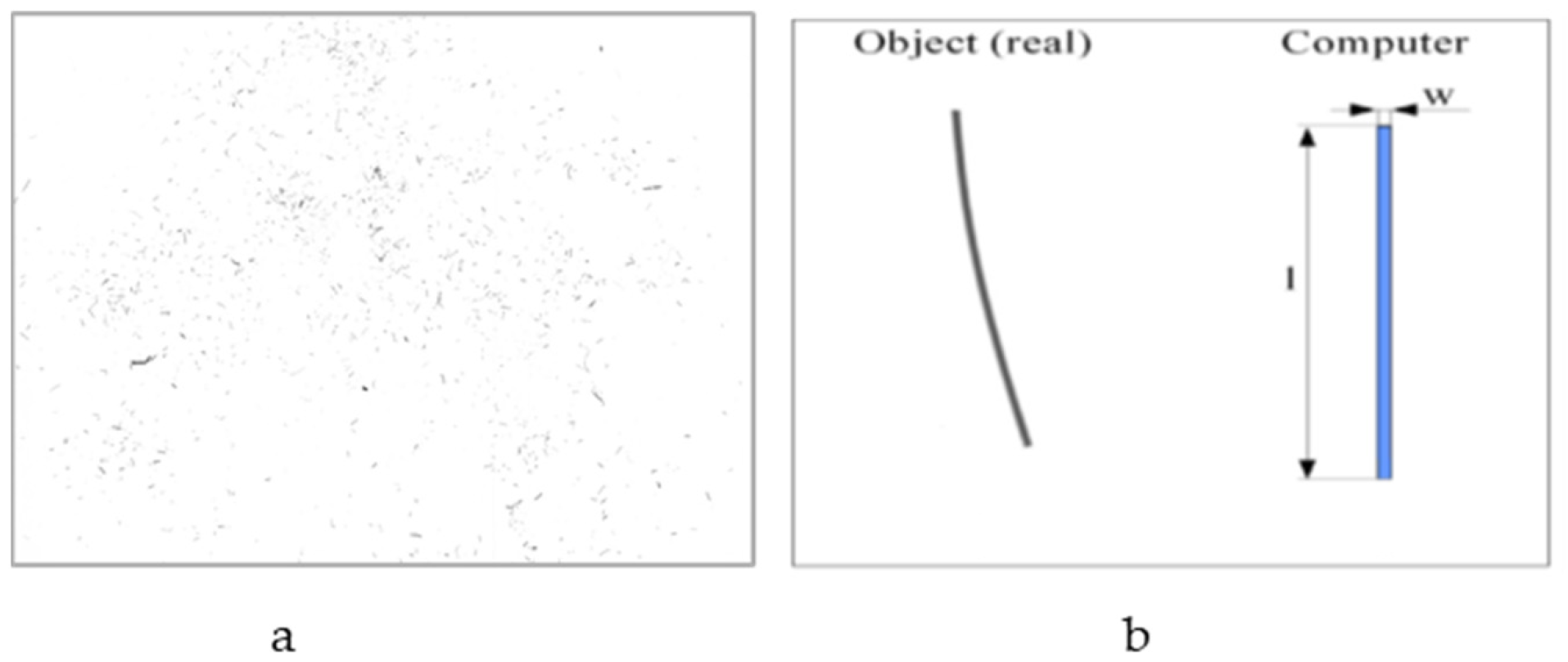

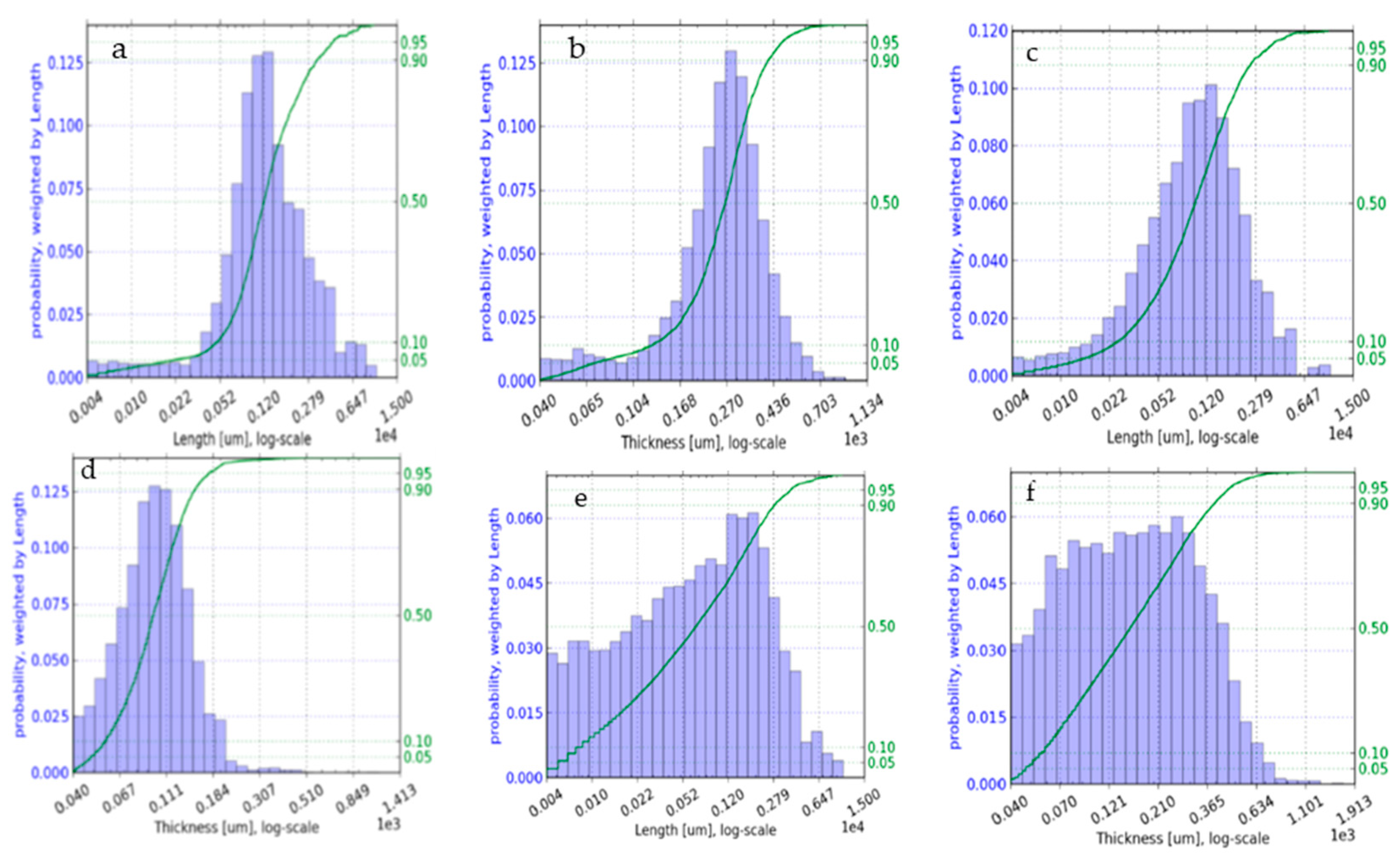
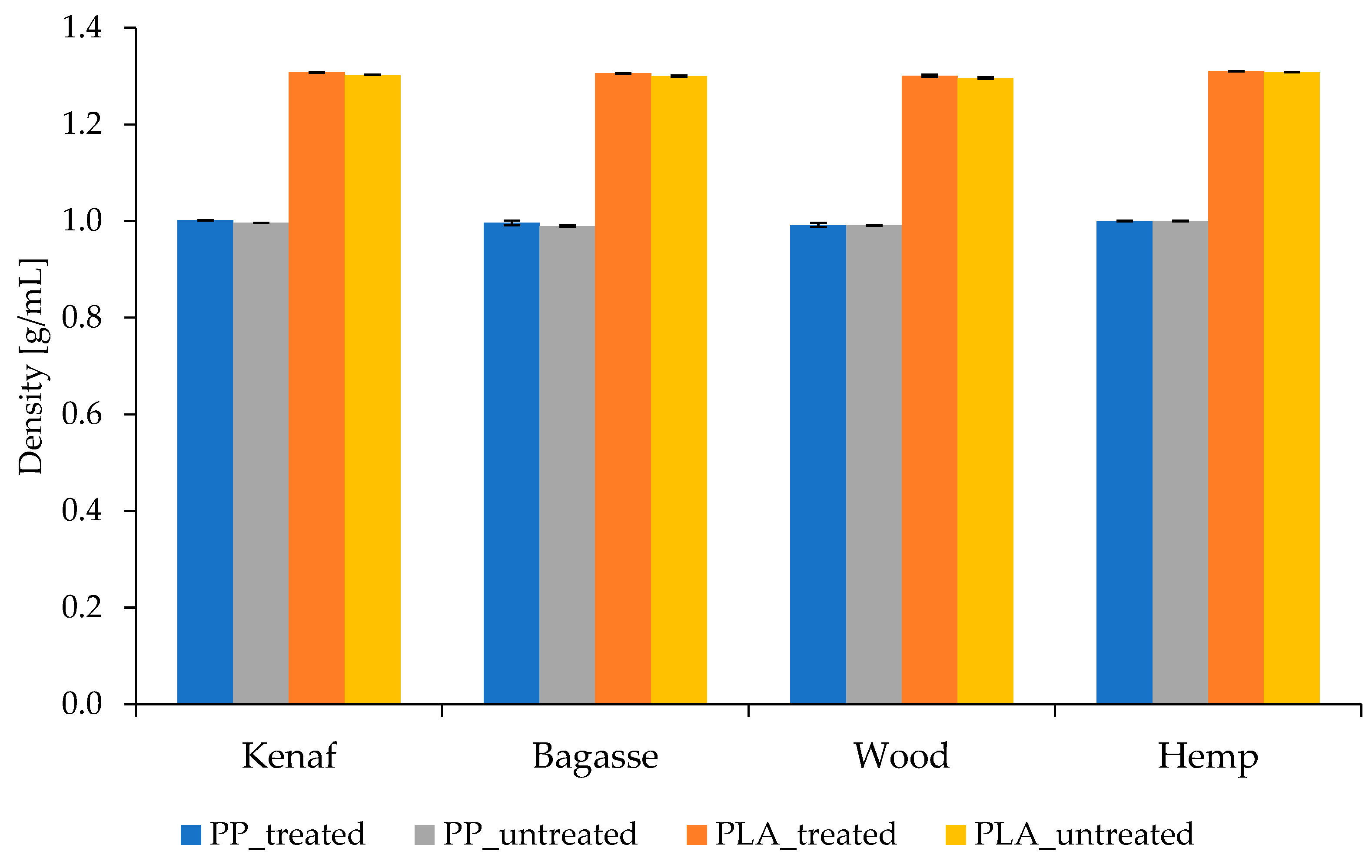
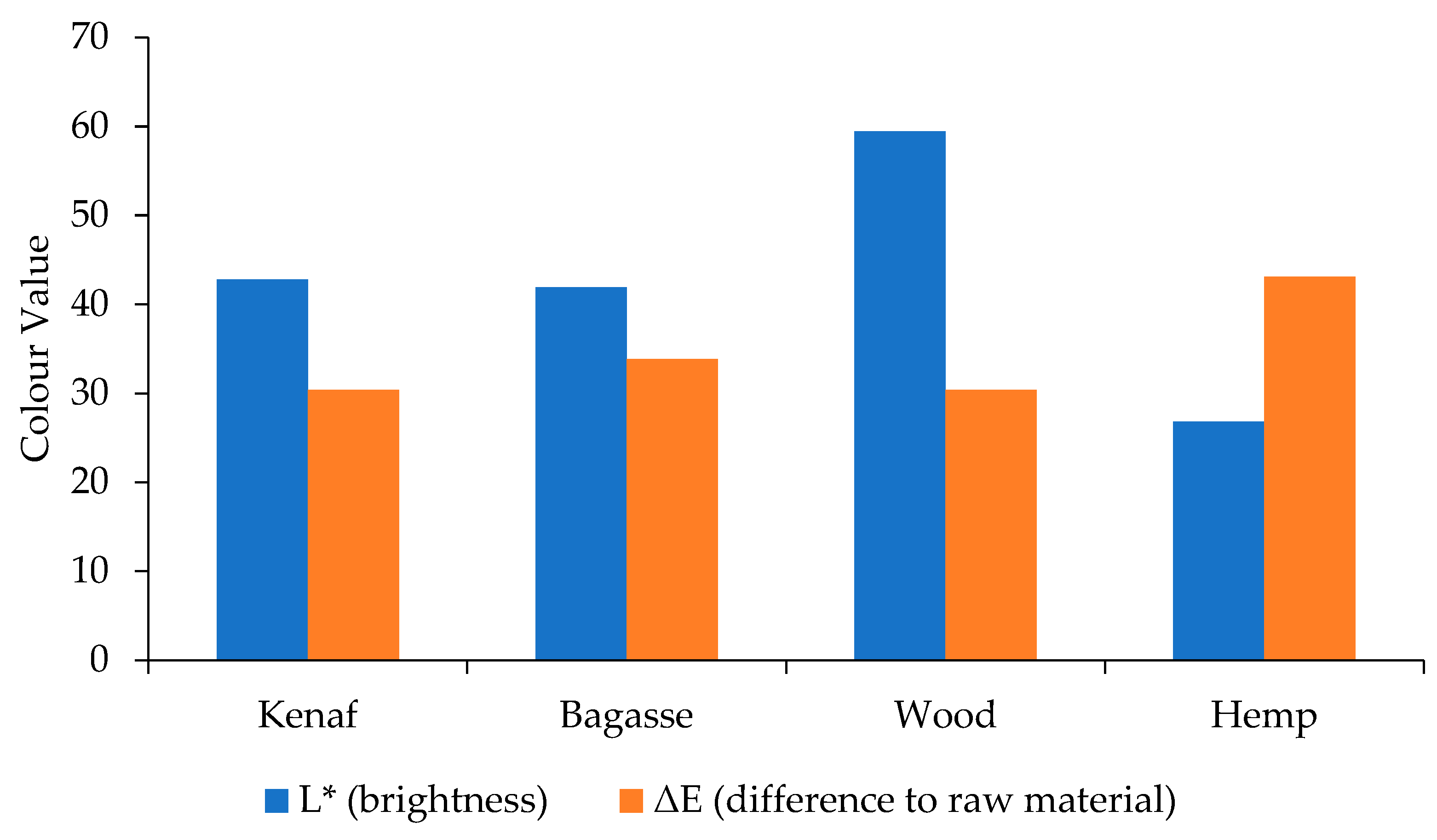
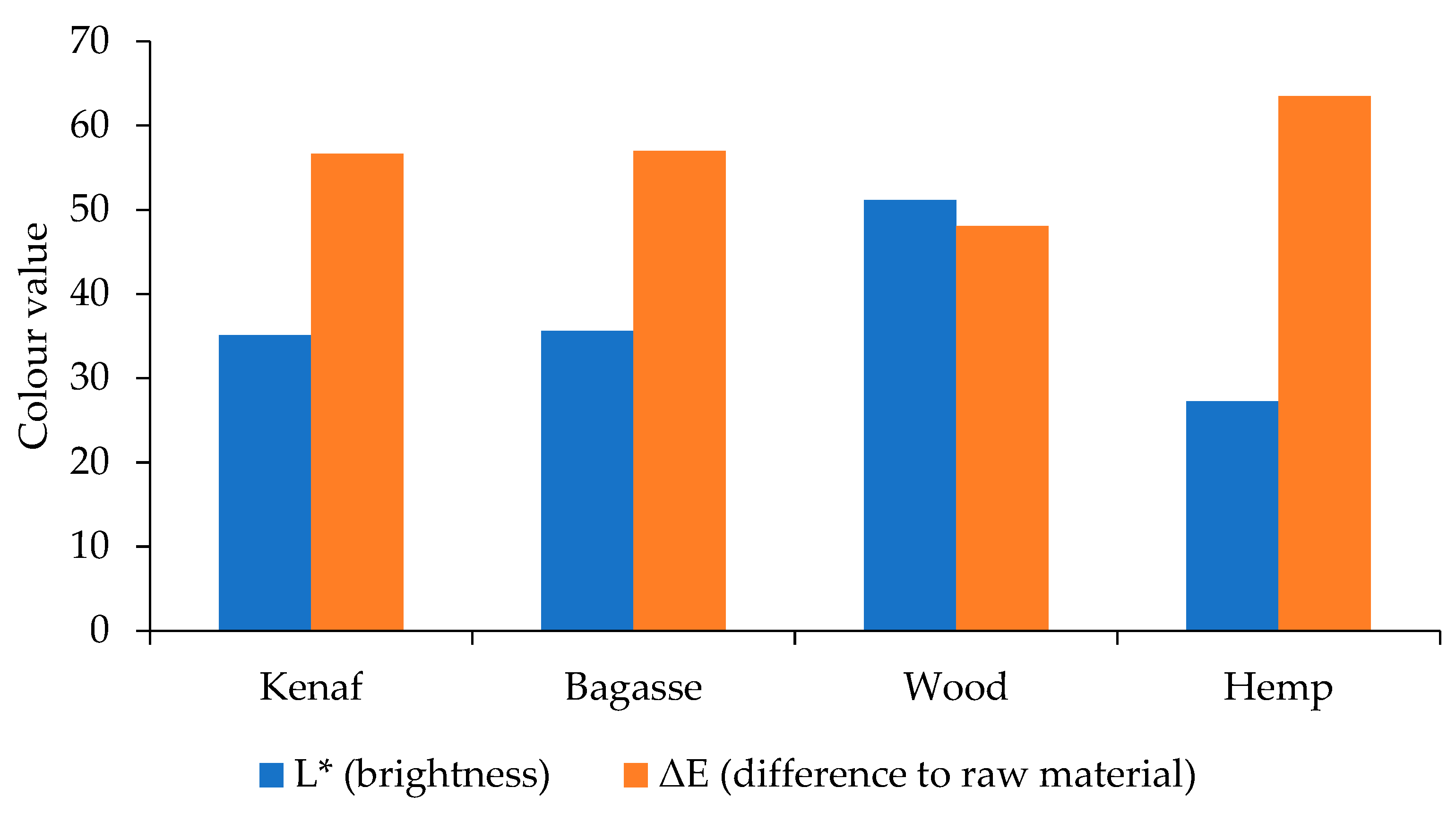

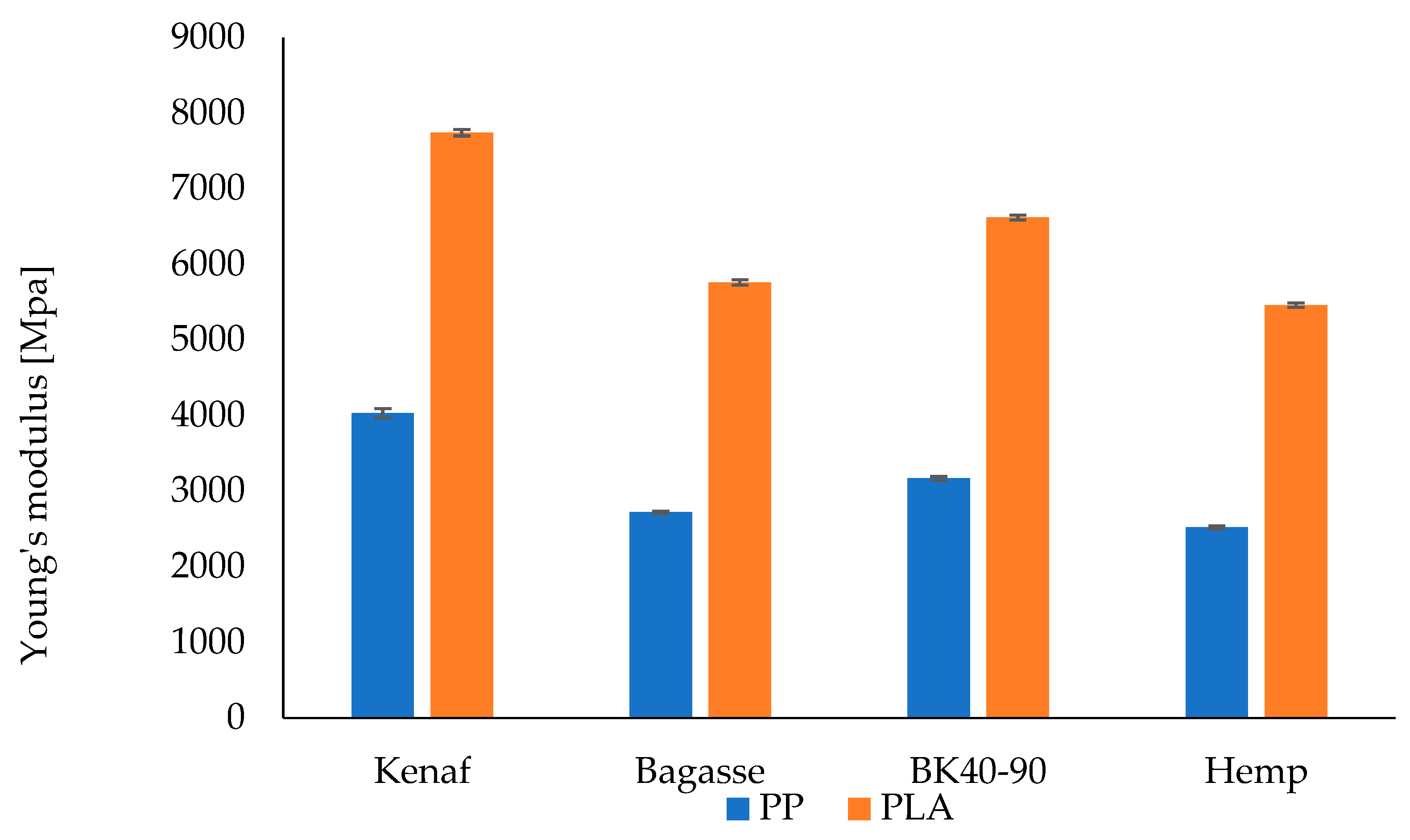
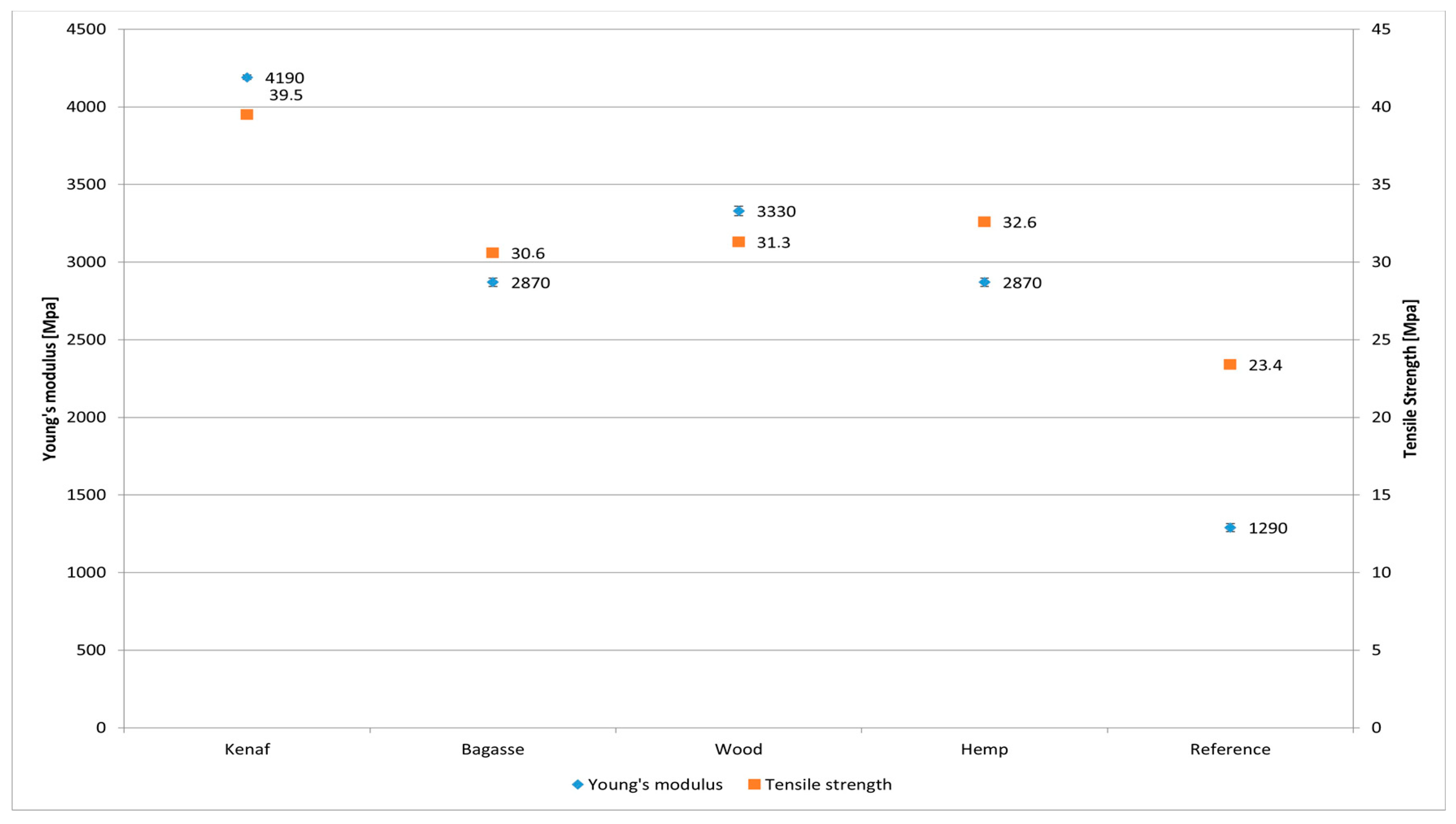
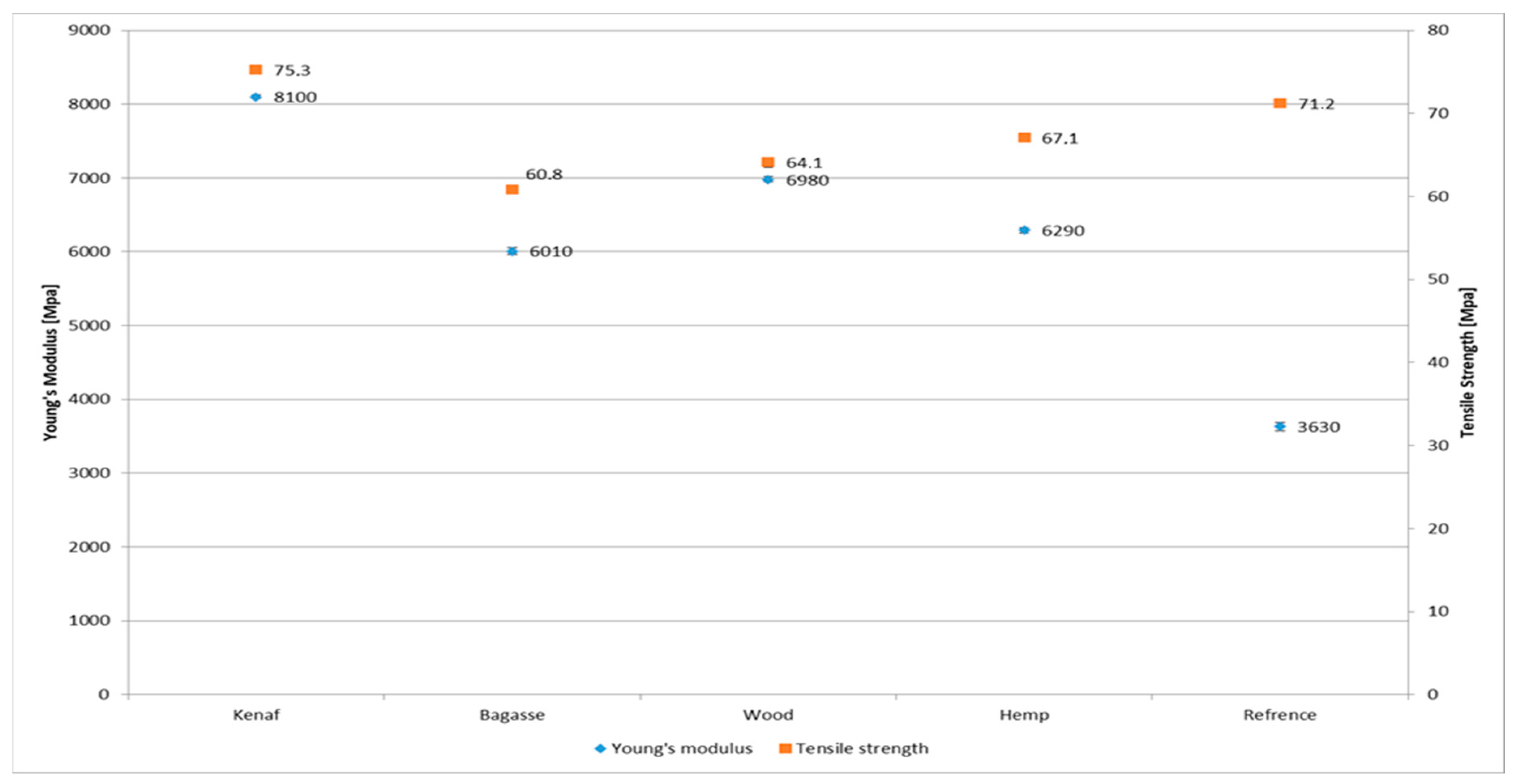
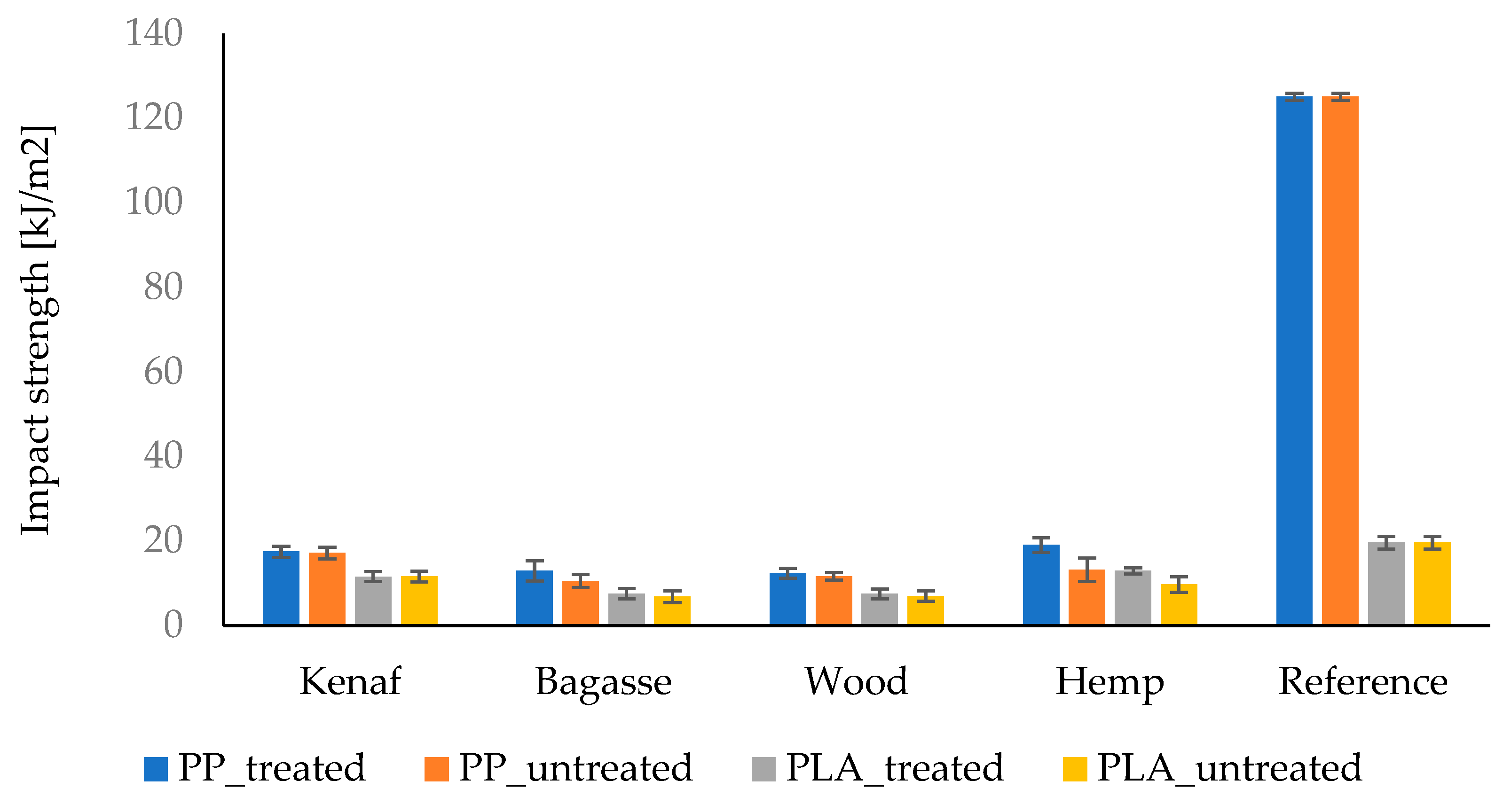

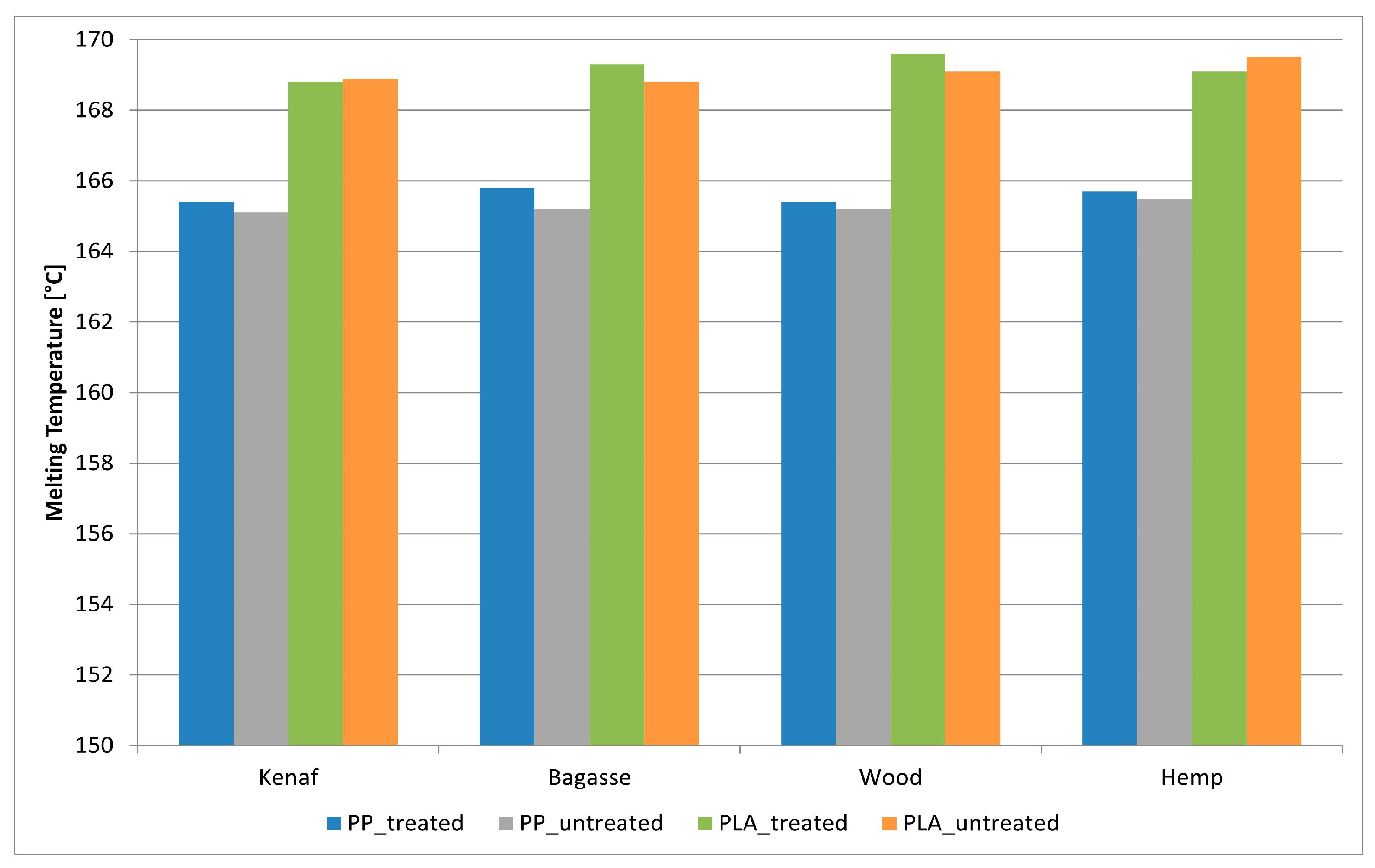
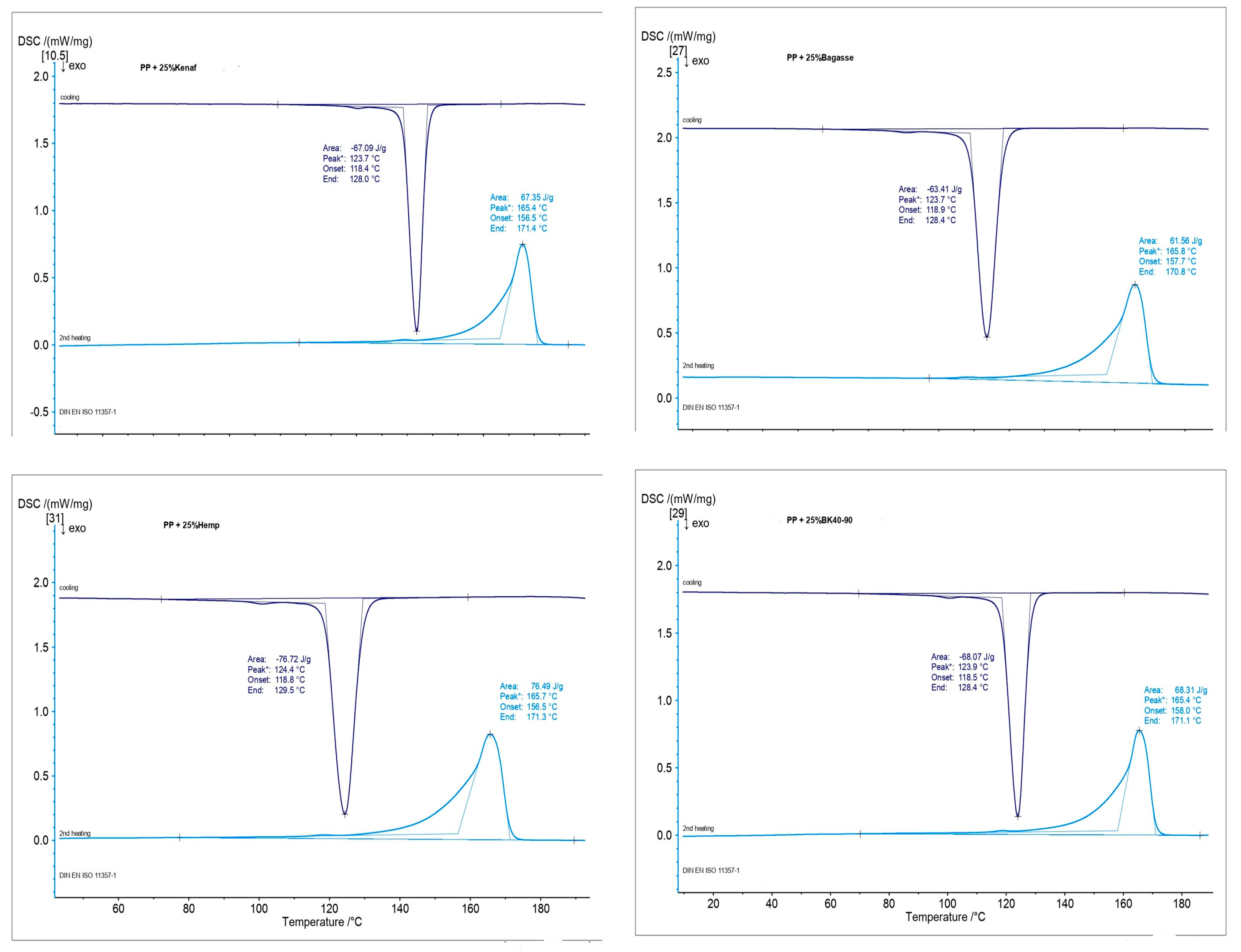
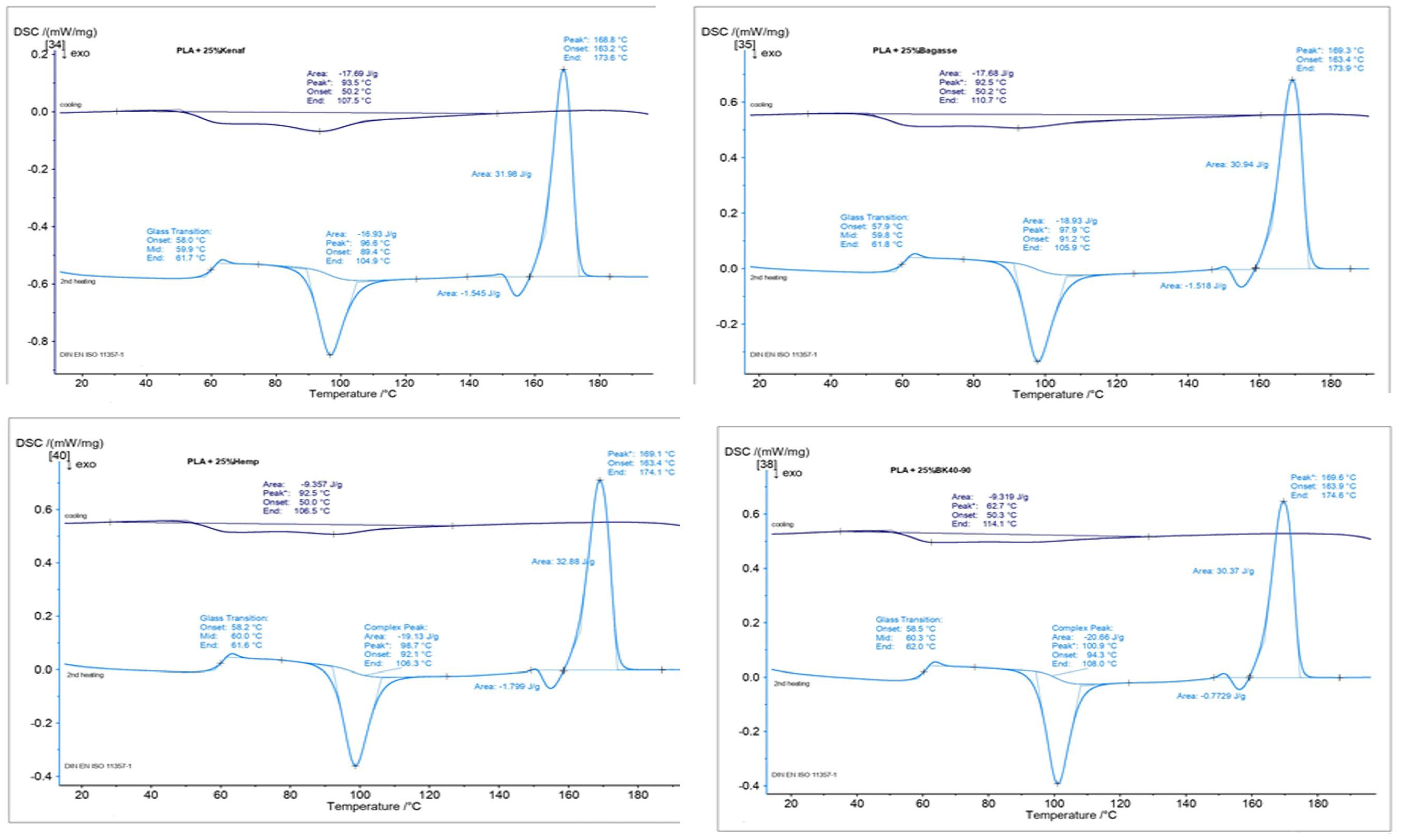
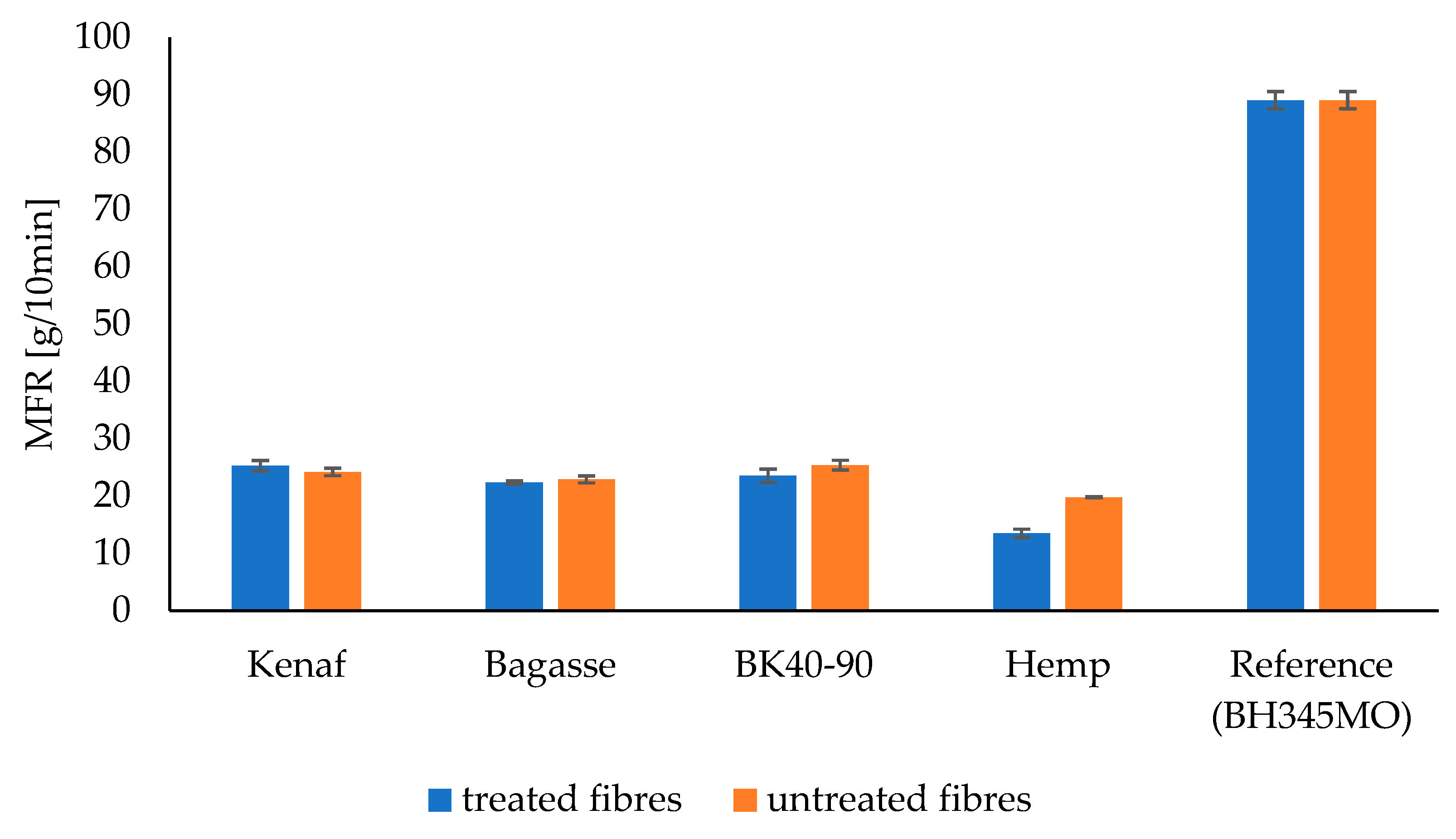
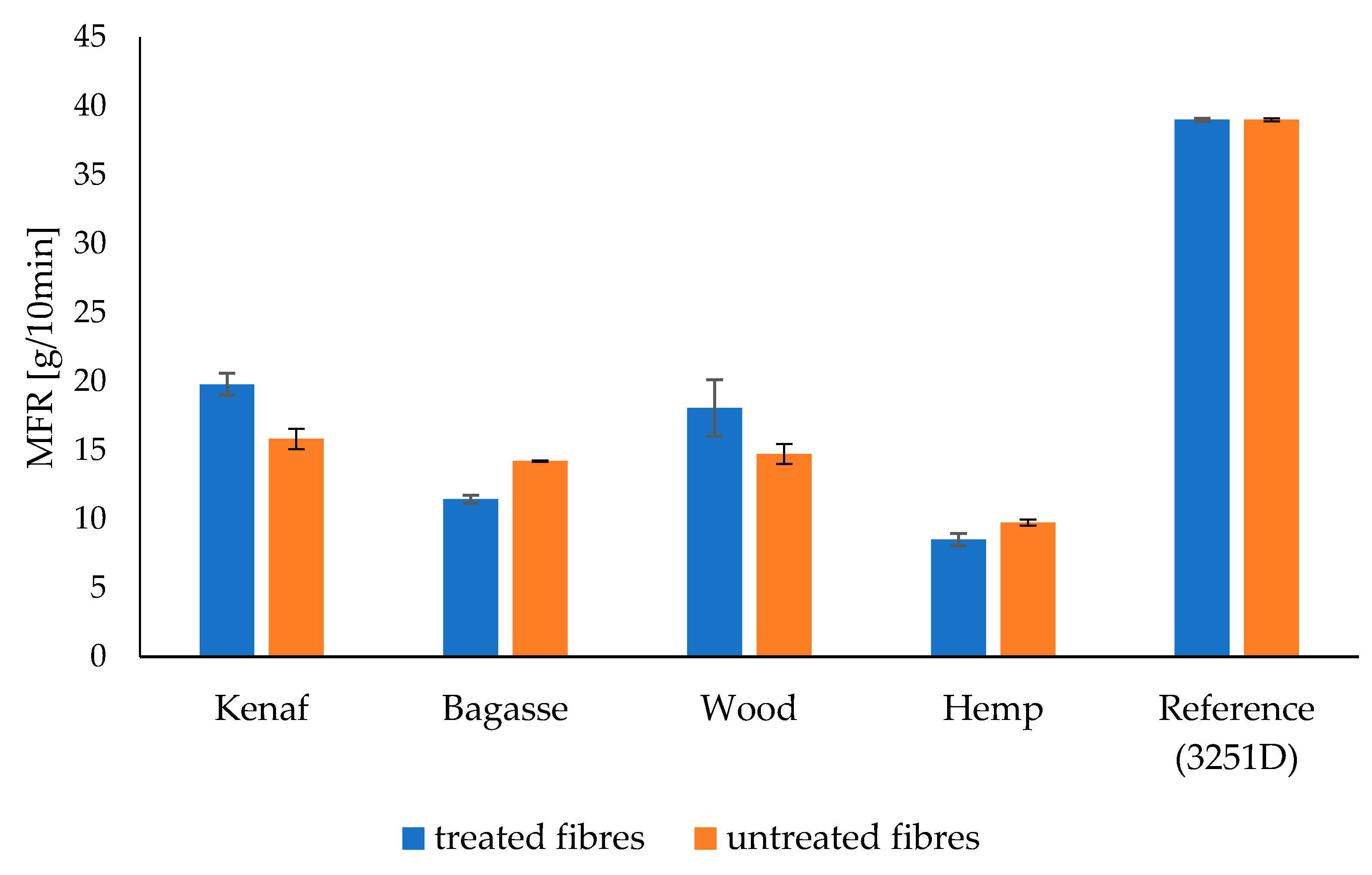
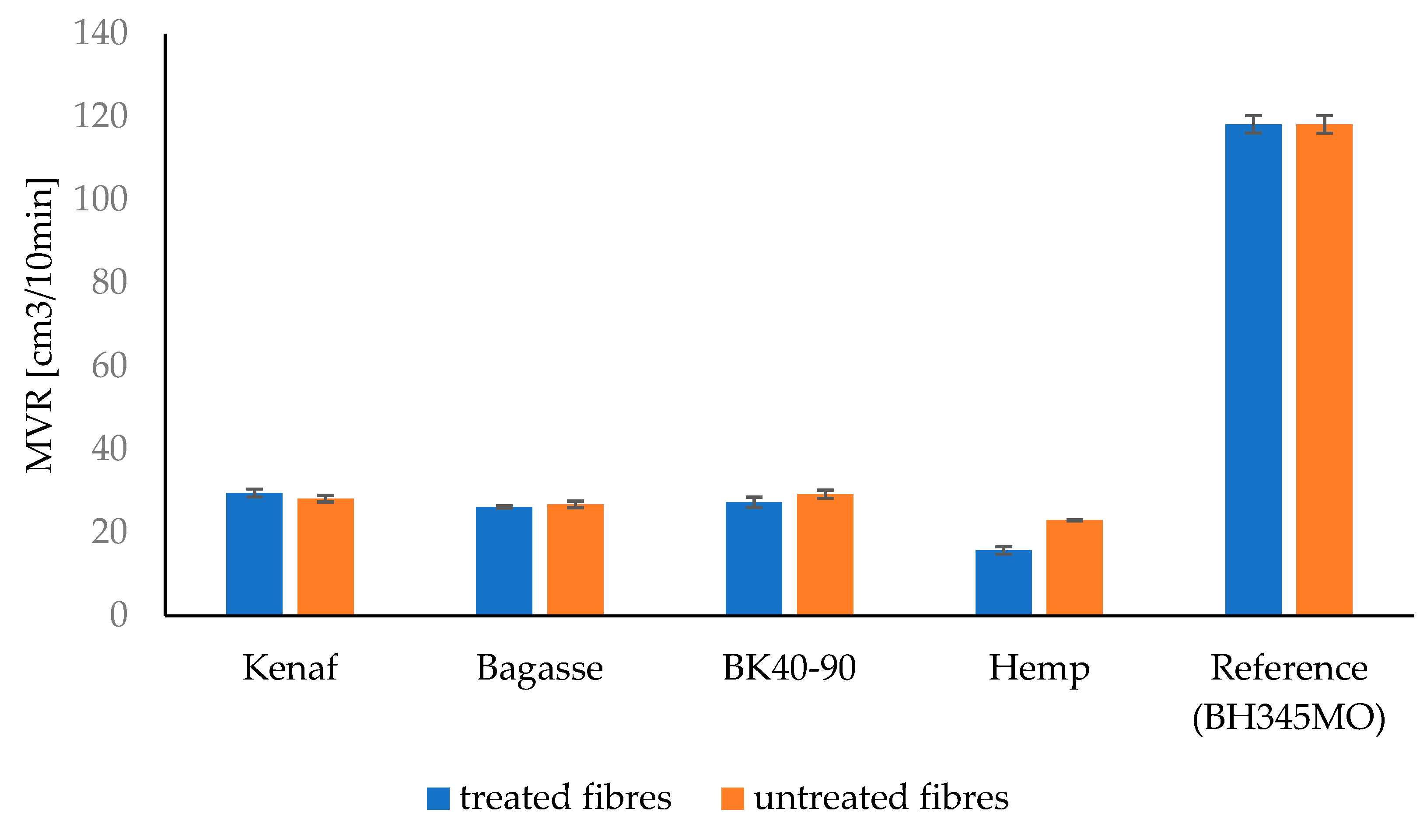


| Fibers | Cellulose (%) | Lignin (%) | Tensile Strength (MPa) | Tensile Modulus (GPa) |
|---|---|---|---|---|
| Kenaf | 60.00 | 22 | 300–930 | 53 |
| Bagasse | 40–50 | 14.90 | 20–50 | 2.7 |
| Hemp | 70–74 | 3.5–5.7 | 550–900 | 70 |
| Fibers | Length Mean Value [µm] | Thickness Mean Value [µm] | Aspect Ratio |
|---|---|---|---|
| Kenaf | 1281.25 ± 17.1 * | 104.42 ± 0.8 * | 12.27 |
| Bagasse | 1175.29 ± 10.5 * | 197.36 ± 1.5 * | 5.96 |
| Softwood | 1638.13 ± 8.4 * | 272.43 ± 2.3 * | 6.01 |
| Hemp | 588.06 ± 3.2 * | 103.95 ± 0.28 * | 5.66 |
| Treated | Untreated | ||||||||
|---|---|---|---|---|---|---|---|---|---|
| MFR | MVR | MFR | MVR | ||||||
| Fibers | Mean | SD | Mean | SD | Mean | SD | Mean | SD | MC% |
| Kenaf | 25.27 | 0.92 | 29.53 | 0.94 | 24.18 | 0.65 | 28.17 | 0.8 | 0.0194 |
| Bagasse | 22.36 | 0.29 | 26.18 | 0.3 | 22.87 | 0.61 | 26.8 | 0.78 | 0.0172 |
| BK40-90 | 23.53 | 1.16 | 27.31 | 1.24 | 25.38 | 0.86 | 29.26 | 0.99 | 0.0172 |
| Hemp | 13.49 | 0.74 | 15.72 | 0.88 | 19.76 | 0.11 | 22.98 | 0.11 | 0.0255 |
| PP | 89 | 1.5 | 118.2 | 2.1 | 89 | 1.5 | 118.2 | 2.1 | 0.00 |
| Treated | Untreated | ||||||||
|---|---|---|---|---|---|---|---|---|---|
| MFR | MVR | MFR | MVR | ||||||
| Fibers | Mean | SD | Mean | SD | Mean | SD | Mean | SD | MC% |
| Kenaf | 19.79 | 0.8 | 16.71 | 0.65 | 15.83 | 0.75 | 13.36 | 0.67 | 0.0194 |
| Bagasse | 11.45 | 0.28 | 9.74 | 0.25 | 14.22 | 0.05 | 12.09 | 0.03 | 0.0172 |
| BK40-90 | 18.08 | 2.06 | 15.34 | 1.76 | 14.73 | 0.73 | 12.45 | 0.62 | 0.0172 |
| Hemp | 8.51 | 0.45 | 7.18 | 0.38 | 9.75 | 0.23 | 8.25 | 0.19 | 0.0255 |
| PLA | 39 | 0.1 | 34.9 | 0.1 | 39 | 0.1 | 34.9 | 0.1 | 0.00 |
Disclaimer/Publisher’s Note: The statements, opinions and data contained in all publications are solely those of the individual author(s) and contributor(s) and not of MDPI and/or the editor(s). MDPI and/or the editor(s) disclaim responsibility for any injury to people or property resulting from any ideas, methods, instructions or products referred to in the content. |
© 2025 by the authors. Licensee MDPI, Basel, Switzerland. This article is an open access article distributed under the terms and conditions of the Creative Commons Attribution (CC BY) license (https://creativecommons.org/licenses/by/4.0/).
Share and Cite
Osman, Z.; Elamin, M.; Ghorbel, E.; Charrier, B. Influence of Alkaline Treatment and Fiber Morphology on the Mechanical, Physical, and Thermal Properties of Polypropylene and Polylactic Acid Biocomposites Reinforced with Kenaf, Bagasse, Hemp Fibers and Softwood. Polymers 2025, 17, 844. https://doi.org/10.3390/polym17070844
Osman Z, Elamin M, Ghorbel E, Charrier B. Influence of Alkaline Treatment and Fiber Morphology on the Mechanical, Physical, and Thermal Properties of Polypropylene and Polylactic Acid Biocomposites Reinforced with Kenaf, Bagasse, Hemp Fibers and Softwood. Polymers. 2025; 17(7):844. https://doi.org/10.3390/polym17070844
Chicago/Turabian StyleOsman, Zeinab, Mohammed Elamin, Elhem Ghorbel, and Bertrand Charrier. 2025. "Influence of Alkaline Treatment and Fiber Morphology on the Mechanical, Physical, and Thermal Properties of Polypropylene and Polylactic Acid Biocomposites Reinforced with Kenaf, Bagasse, Hemp Fibers and Softwood" Polymers 17, no. 7: 844. https://doi.org/10.3390/polym17070844
APA StyleOsman, Z., Elamin, M., Ghorbel, E., & Charrier, B. (2025). Influence of Alkaline Treatment and Fiber Morphology on the Mechanical, Physical, and Thermal Properties of Polypropylene and Polylactic Acid Biocomposites Reinforced with Kenaf, Bagasse, Hemp Fibers and Softwood. Polymers, 17(7), 844. https://doi.org/10.3390/polym17070844









